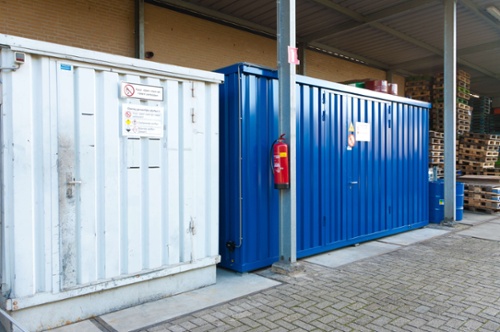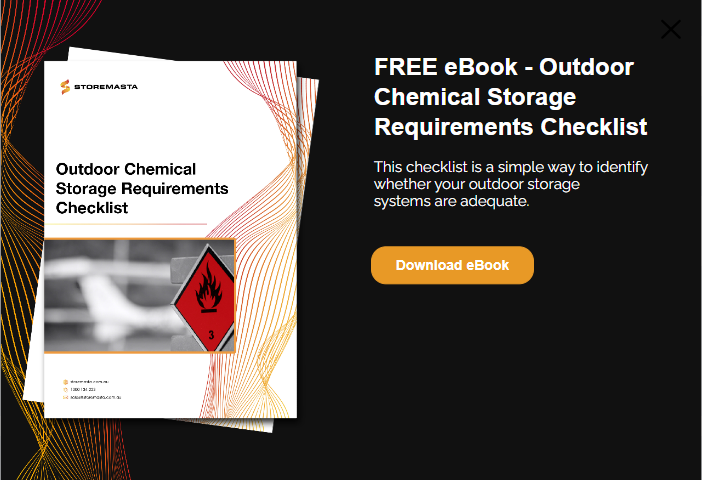Whether you’re carrying large amounts of hazardous chemicals or you’ve just introduced a new chemical product to your worksite, you will have to consider the storage options for your dangerous goods. In many businesses, storing chemicals outdoors is a more practical and convenient option. But what type of chemical store will you require and what will best suit your needs? In this blog, we’ll be answering an often-after question, ‘What is a DG container?’ and highlighting the key benefits of choosing this type of chemical storage container. We’ll also be detailing how this type of chemical store can protect your business from hazards such as spillage and the build-up of hazardous vapours.
So, What Exactly Is A DG Container?
A DG container, otherwise known as a dangerous goods container, is a type of outdoor chemical storage unit. DG containers are fully relocatable chemical stores which are used across a broad range of industries including mining, agriculture, manufacturing, and many other industries.
There are many options for chemical storage if you’re considering a chemical storage container including small or medium-sized chemical stores, outdoor drum stores and IBC storage containers.
However, DG containers are often a popular choice for organisations who want a large-capacity outdoor chemical store that can be easily moved to a remote worksite or simply relocated to a new address.
The benefits of using a DG container, when compared with other types of outdoor chemical storage containers include:
- Fully relocatable chemical store – these containers are made to be moved. Look out for containers that feature heavy duty base plates and lifting lugs for easy transfer from site to site
- Large chemical capacity – a DG container has the capacity to store greater amounts of hazardous chemicals than many other types of outdoor storage containers
- Flexibility – your DG container can take a range of chemical packages including drums and IBCs. It’s also large enough to be used for other chemical transfer tasks such as decanting or pumping
- Walk-In Design – this type of container is unique in the fact that it is designed so that staff can walk into the container to access or use their stores of chemicals
- Able To Be Customised – DG containers can be customised with racking, shelving, eye wash facilities or other additional features. They may also be custom manufactured to store multiple classes of dangerous goods
What Types Of Dangerous Goods Can You Store?
As with any type of chemical cabinet or outdoor store, you must choose the solution that suits the type and quantity of hazardous chemical or dangerous goods that your business is carrying.
/How%20to%20manage%20hazardous%20chemicals%20in%20the%20workplace.jpg?width=500&name=How%20to%20manage%20hazardous%20chemicals%20in%20the%20workplace.jpg)
A compliant DG container will be manufactured to meet the requirements of the particular chemical class that you're carrying.
DG containers are manufactured to meet the requirements of the Australian Standards, with available options for many types of dangerous goods. Chemical classes that are often stored in DG containers include Class 3 Flammable Liquids, Class 6 Toxic Substances and Class 8 Corrosive Substances. However, remember to check your Safety Data Sheets to ensure that the type of container that you choose is suitable for the product that you’re carrying.
IMPORTANT: When selecting any type of equipment to house or transfer your dangerous goods, we recommend conducting an onsite risk assessment. Your risk assessment should determine your storage requirements including the feasibility of having your chemicals stored in the outdoor environment.
Key Engineering Controls
The number one reason why you would need a DG container (or any type of dangerous goods storage) is to protect your people, property and the environment from the risks associated with your stored hazardous chemicals.
If your risk assessment has deemed that outdoor chemical storage is appropriate for the products that you’re looking to store, then choosing a DG container may be a good fit for your operations.

Start with a risk assessment to properly determine your dangerous goods storage needs.
As we discussed earlier, DG containers are suitable for a range of applications from remote mining sites storing flammable liquids to manufacturing premises that are carrying large volumes of toxic substances. But what are the key control measures that make this type of container a high-tech risk control measure for your business?
Let’s look at some of the features of a DG container — and how they can help you create a safer and more compliant environment in your workplace.
Spillage
If you’ve been working with any type of hazardous liquid in your organisation, you can understand how easily a chemical leak or spill can occur.
When you’re using large containers, drums or IBCs of chemicals, there are many ways that spillage can occur. While you should always keep chemical packages closed when not in use — and ensure that safe stacking and loading practices are followed — you are also legally obligated to contain any hazardous chemical spills in your workplace.
Using bunded storage products, such as a compliant DG container, allows your business to have a liquid-tight spill containment system to catch any leaks or spills. Without such protection, your business could suffer from an uncontrolled chemical spill, which could quickly spread throughout your workplace and into the natural environment. Choosing a DG container to store your chemicals outdoors is a safe and secure option that will minimise your risk of a hazardous chemical spill.
Security
When you’re storing hazardous chemicals indoors, there are a variety of security measures that will protect your chemicals from misuse, vandalism or theft. Things like lockable cabinets, security cameras and lockable work areas all provide extra security that reduces the risk of your chemicals going missing or being misused.
However, in the outdoor environment, it’s important to choose a chemical storage option that offers suitable security for your valuable (and hazardous) products. While it’s a requirement of the Australian Standards that chemical storage areas have security measures, such as secure fencing with barb wire on top, your DG container is already equipped with durable locking bars.
ISO locking bars offer compliant security for your hazardous chemical stores. The bars are constructed from steel and feature a locking mechanism that meets the requirements of the Australian Standards. This type of feature will prohibit and deter unathorised entry, thereby reducing your chemical risk — as well as the financial cost of theft and vandalism.
Protection
Theft or vandalism are not the only threats that your chemical store may face.
You’ll also have to consider how your dangerous goods would be protected in the event of extreme weather (ie. hail, strong winds) or a workplace accident (ie. equipment being accidently run into your store).
Unlike shipping containers or indoor chemical cabinets, DG containers are specifically designed and constructed to be installed outdoors. Therefore, they are already manufactured with a range of features to reduce risk and increase the lifespan of the container. Such features may include a durable steel construction, corrosion protection, and a cambered roof for efficient rain water runoff.

Your DG container should offer protection from spillage, unathorised entry and impact damage.
To make sure that your container stays in good working order and maintains compliance, you should create a regular schedule of inspections as well as strict housekeeping procedures. While your container may comply with WHS Regulations when it arrives onsite, if you notice any dents, corrosion or damage, it must be rectified to retain its safety features.
REMEMBER: While compliant DG containers are already made to withstand cyclonic winds, you can opt for a higher cyclone rating if you’re situated in an area that’s prone to cyclones. You may also add extra corrosion protection if you are located in a coastal position. Speak with your manufacturer about customising your container to suit the conditions of your worksite.
Ventilation
Have you ever opened a safety cabinet only to be hit by a strong smell of chemicals? There are many ways that hazardous vapours and gases can be released from your dangerous goods, including spillage, leaking packages, containers not being wiped down after use, and lids being left off or not secured correctly. However, you should also monitor the level of vapours in your workplace to ensure that your ventilation system is adequately dispersing the harmful vapours.
In Australia, the Workplace Exposure Standards detail the concentration of airborne contaminants that are considered safe for workers to be exposed to. When ordering any type of hazardous chemical for your business, we suggest that you first review the Workplace Exposure Standards — and consider if your ventilation requirements are compliant.
Storing chemicals in the outdoors is often a better choice for organisations who carry large quantities of dangerous goods that emit harmful vapours. However, it’s important to note that a natural ventilation will be required so vapours don’t build-up in the store.
DG containers should be equipped with a natural ventilation system that complies with the applicable Australian Standard. Two walls of louvres are deemed a compliant natural ventilation option for chemical storage containers in an outdoor environment.
Why Do You Need One?
As we’ve outlined in this blog, there are many reasons why organisations choose to store their chemicals in a DG container. This type of outdoor chemical store provides sufficient natural ventilation, protection from impact damage, and a liquid-tight spill containment system to prevent uncontrolled chemical spills.
If you’d like to learn more about storing larger amounts of chemicals outdoors, we have a handy checklist that can help. Our checklist will explain the considerations you’ll have to make when choosing a storage facility for your hazardous chemicals. Access your free checklist today and take the next steps towards chemical compliance.
Joining the team as a Dangerous Goods Storage Consultant, Melissa Hampton became Storemasta's Marketing Manager in late 2021. With extensive knowledge and experience in chemical compliance, Melissa is responsible for leading the Marketing team and helping shape their marketing strategy. In her spare time, you can find Melissa hiking, swimming and enjoying the great outdoors in beautiful north-west Tasmania.

